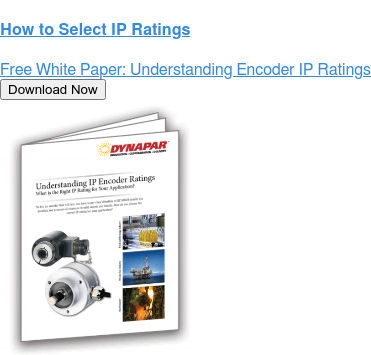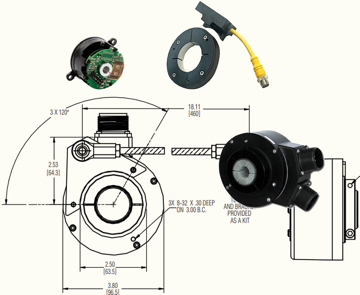How Temperature and Humidity Affect Encoder Performance
For high industrial environments, engineers must be account for difficult environmental conditions such as extreme temperatures, high humidity, and large amounts of water. When selecting high temperature encoders need to consider thermal expansion of materials and components such as the encoder disk at high temperatures and the maximum operating speed at the highest expected temperature. When specifying encoders for low temperatures, thermal contraction and additional starting torque due to hardened lubricants should be considered.
Here, we review the effects of these factors and more on encoder performance and lifetime, and discuss how to specify the appropriate device.

Effects of Temperature on Encoder Performance
In an optical encoder, a code disk passes between an LED and a photodetector, modulating the beam to generate either a pulse stream that can be processed to yield speed, direction and/or position. Optical encoders use code disks made of glass, Mylar, or metal. Magnetic encoders operate on a similar principle, but use wheels patterned with magnetic domains. In both cases, extreme temperatures and moisture can impact performance, mechanical properties, and lifetime.
Thermal expansion at high temperatures is a problem. In optical encoders, the air gap between the disk and the source/detector can be as narrow as 0.020”. Depending on the temperature, the size of the gap, the coefficients of thermal expansion (CTEs) of the materials, and the orientation, this expansion could bring the components in contact with one another, causing damage or even catastrophic failure.
Extreme temperatures can also damage the discs themselves. High temperatures can discolor Mylar, introducing signal distortion. Extreme conditions can distort the disk itself. Heat can also degrade bearings, lubricants, and seals, leading to early failure of the overall unit.
Low temperatures such as those found in mining, oil and gas, and off-road applications, present a different set of issues. Thermal contraction can distort the code disk of an optical encoder, affecting signal quality and potentially introducing anomalies. Bearings and lubrication can become a problem. Lubricants harden at low temperatures. If the encoder has been sitting idle, then the lubricant will not be evenly distributed around the bearings at startup. This situation could result in damage to the components of the bearing, due to friction between the rolling elements and inner or outer race of the bearings. The consistency of the lubricant can also substantially increase starting torque.
Thus far, we have focused on optical encoders. Thermal extremes also affect magnetic encoders, although to a lesser degree. Expansion and contraction of the magnetic wheel can alter the pitch of the magnetic poles, altering the output. Air gaps are less of an issue. Typically, modern magnetic encoders a have wide air gaps (up to 0.070”) and any variation caused due to thermal expansion or contraction are within the tolerance range of workable airgap.
How to Choose an Encoder for Extreme Temperatures
All of these factors make it essential to take temperature into account when specifying an encoder. Be aware that exceeding the recommended speed of an encoder will decrease its thermal tolerance. Consider an encoder rated for -40°C to 85°C with a recommended top speed of 3000 RPM. For every 1000 RPM above that speed, the temperature is typically de-rated by 10.
Make sure the manufacturer has qualified the unit using highly accelerated lifetime testing (HALT). This includes the performance of the design when exposed to thermal shock (rapid and wide swings of temperature) along with vibrations. These conditions can be a particular problem for fragile components like glass code disks.
The performance demands of the application may also come into play. There is a trade-off between the quality of the disk and resolution. Glass and metal code disks are limited. The highest resolution encoders use Mylar code disks, which are more susceptible to temperature extremes. Don’t assume that higher resolution is necessarily better. Encoders can only report position, they cannot compensate for mechanical errors in the system. When specifying resolution, be sure to select a level that will actually benefit the application. Learn more about encoder accuracy and resolution here
Effects of Humidity on Encoder Performance
Moisture is a problem in a range of applications including marine environments, industrial manufacturing such as papermaking, and washdown environments like those found in pharmaceutical manufacturing and food preparation. Humidity can degrade optical surfaces to attenuate the signal in optical encoders. It also damages electronics, leading to early failure. This is a particular problem in corrosive environments such as marine environments or those involving harsh chemicals. For these applications, OEMs are best off choosing components with ingress protection (IP) ratings. Learn how to choose IP rated encoders in this white paper
IP-rated components are designed specifically to survive the conditions listed. IP64 units, for example, are dust tight and can tolerate low pressure water spray, while IP66 components can handle high-pressure water jets, and IP67 units can protect against immersion up to a specified depth. Special measures include encapsulated electronics, sophisticated seal designs on the bearings, alternative materials for seals and lubricants, and specialty housings.
Depending on the resolution and performance requirements, a magnetic encoder may be a better solution. Magnetic encoders are not impaired by moisture. They can operate in humid environments and even totally immerse in liquid.
Study the conditions of your application before looking for an encoder. Understand the IP rating system to choose a device that will provide the lifetime required. Talk to your vendor to ensure that the devices have been properly qualified and discover any specialty mounting requirements.
For the most extreme environments, the best feedback option may be a resolver. These devices do not contain any onboard electronics. They perform well under the harshest conditions. Talk to your vendor to determine if a resolver is right for you.
Additional Resources
White Paper: How to choose IP rated encoders
How to select hazardous rated encoders
How to troubleshoot common encoder signal issues
Case Study: See how Dynapar’s hall effect encoder delivers reliable feedback in harsh conditions


